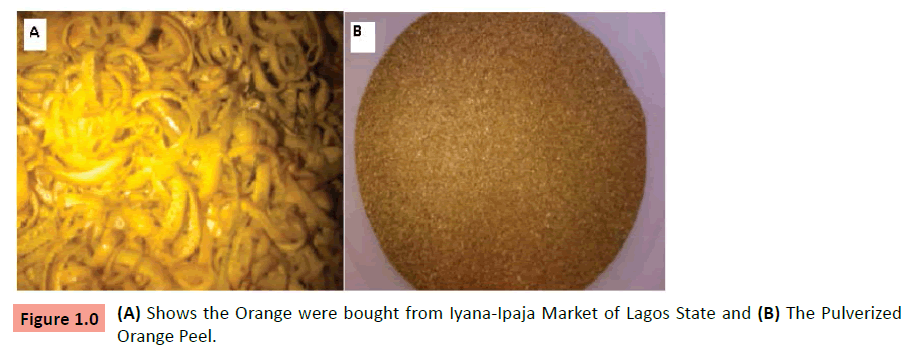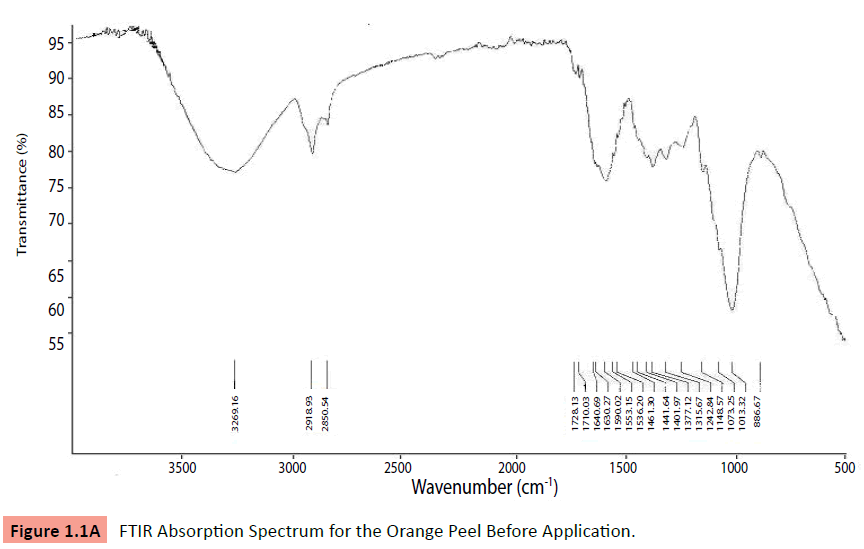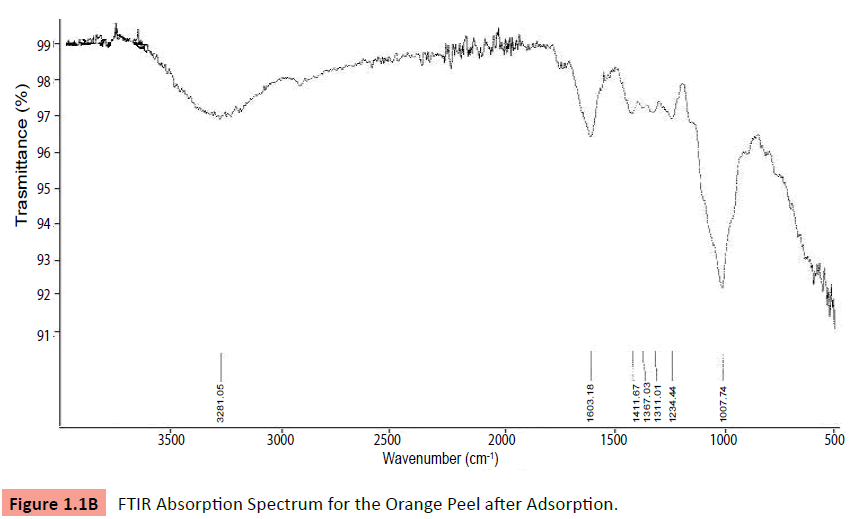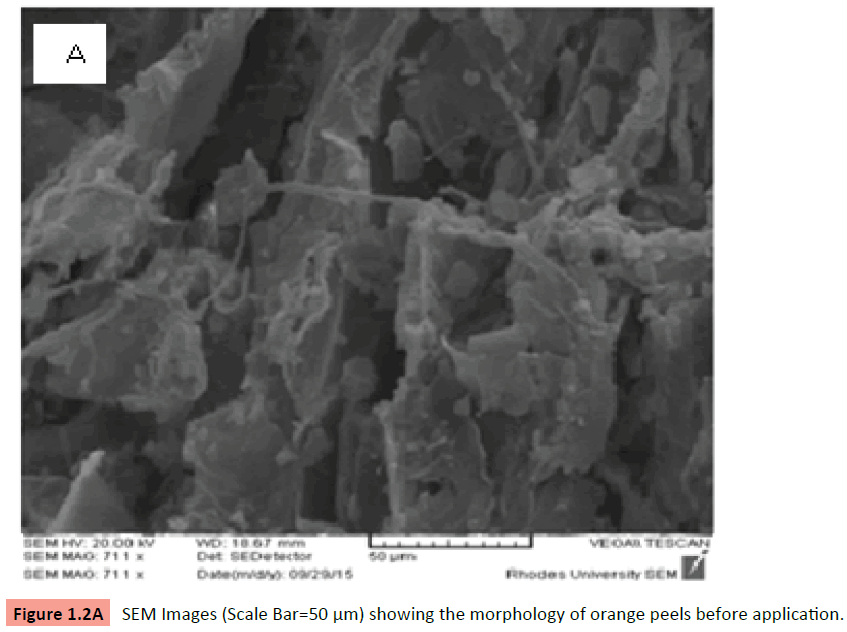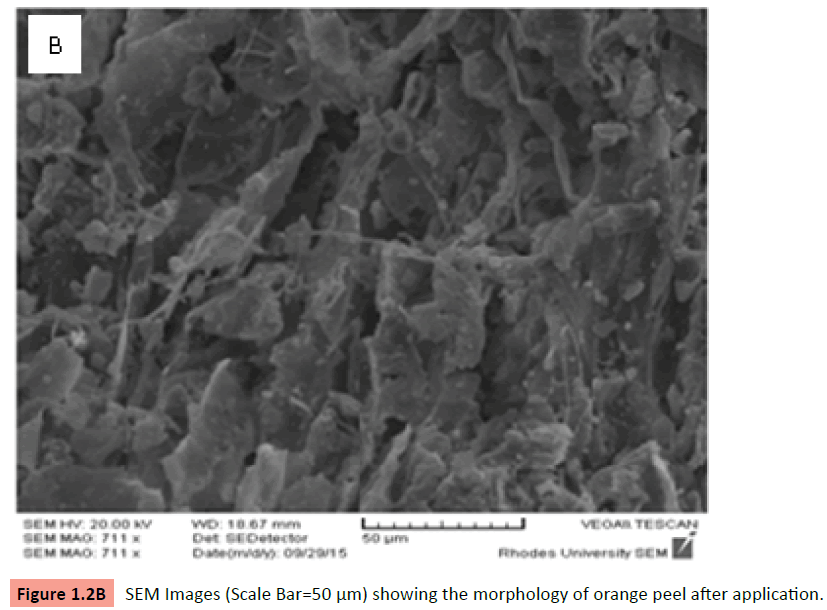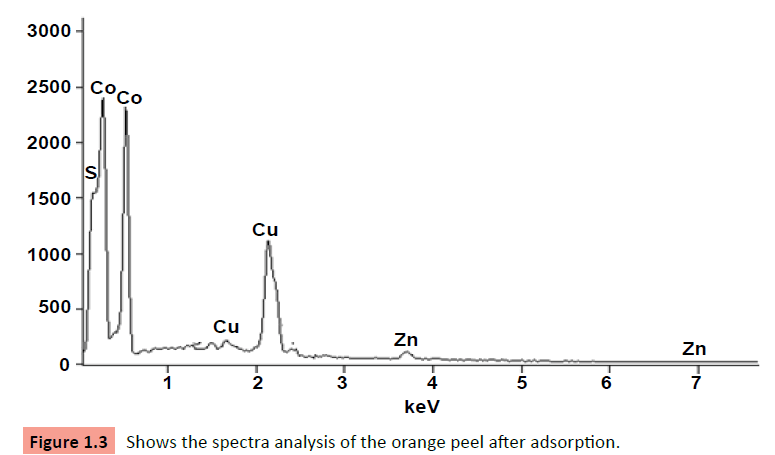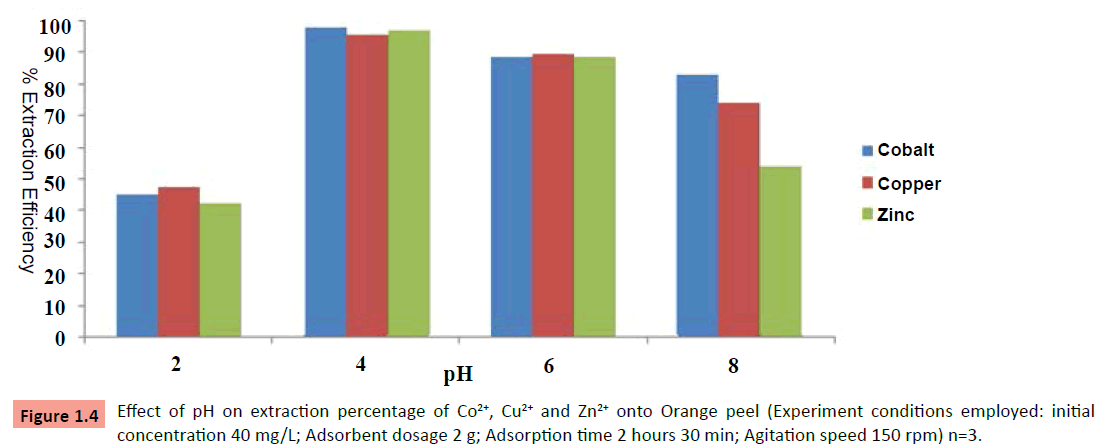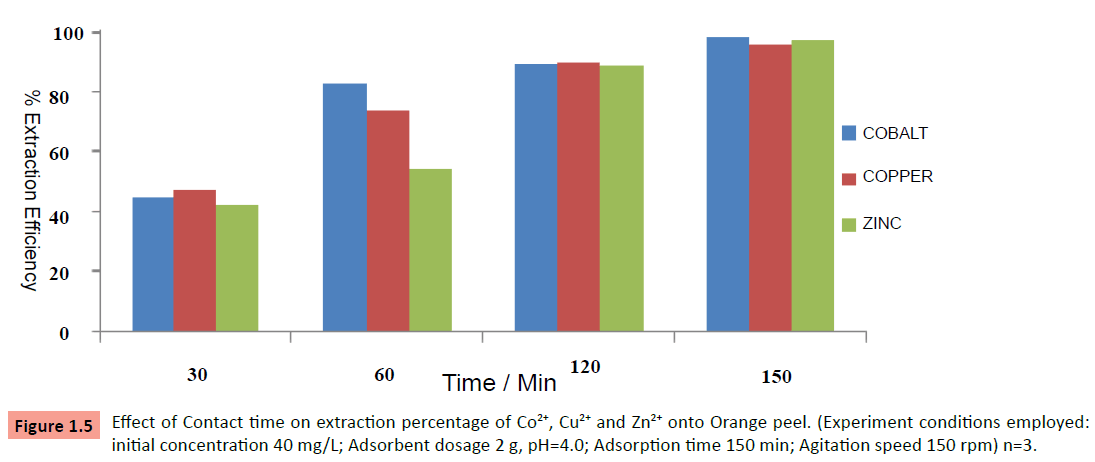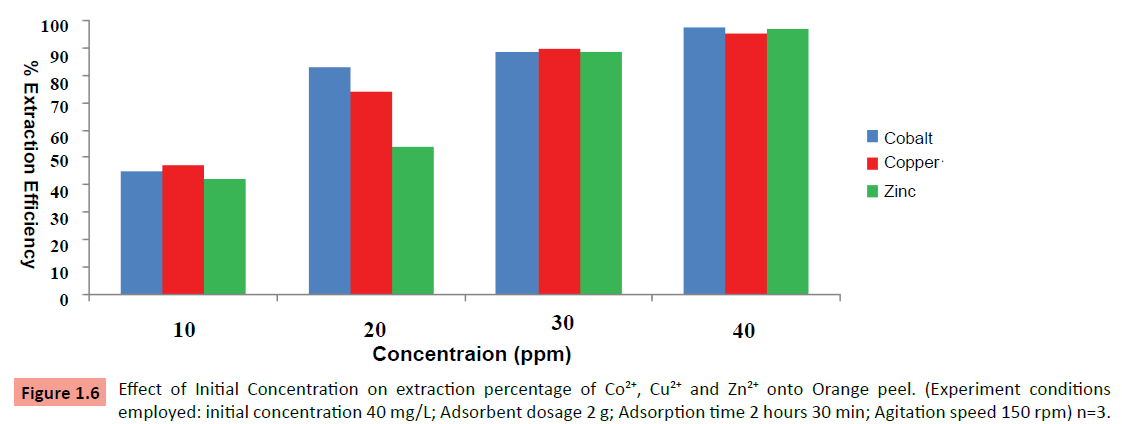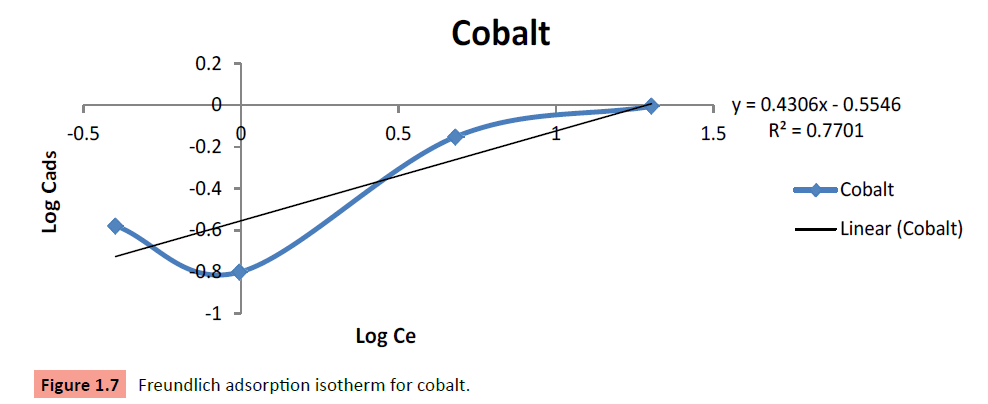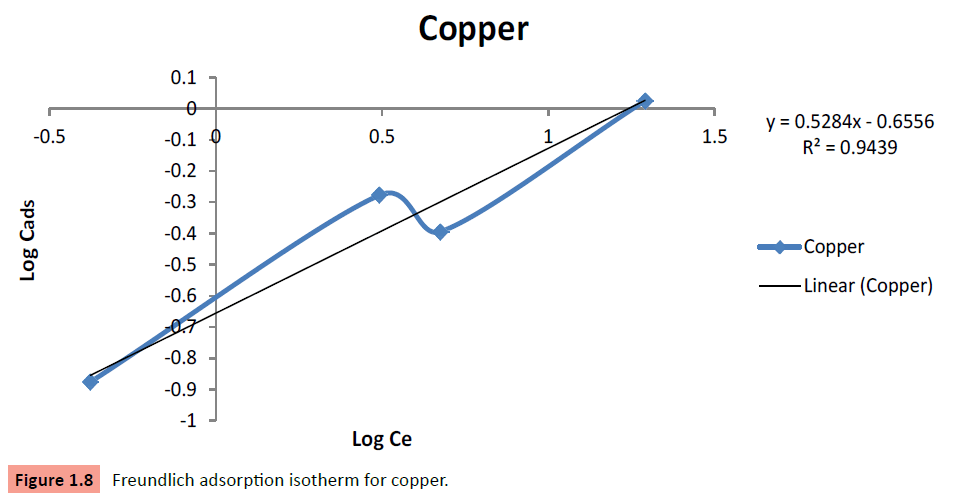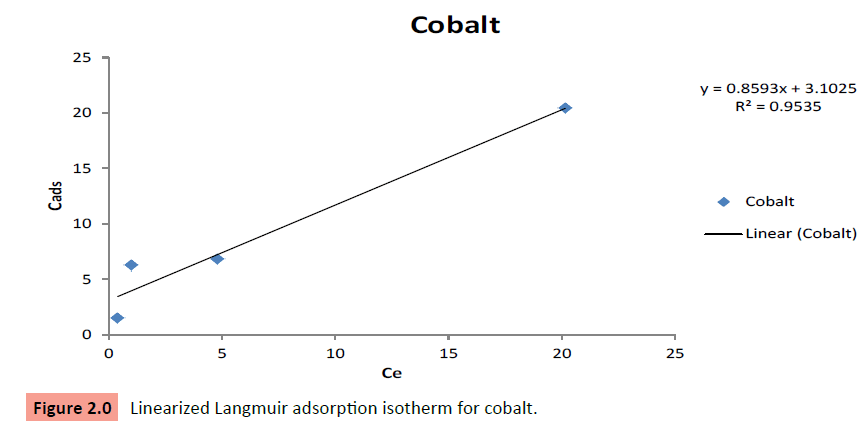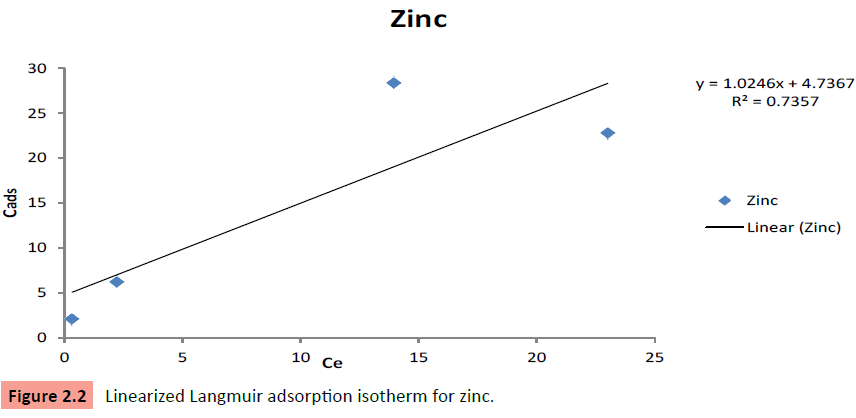The Adsorption of Divalent Metal Ions from Aqueous Media Using Unmodified Orange Peel (Musa sapientum) as Adsorbent
Moronkola BA, Giwa-Ajeniya AO, Alegbe MJ, Eshilokun AO, Awokoya KN, Okoh OO
DOI10.21767/2472-1123.100013
Moronkola BA1*, Giwa-Ajeniya AO1, Alegbe MJ1, Eshilokun AO1, Awokoya KN2 and Okoh OO3
1Department of Chemistry, Lagos State University, Ojo PMB 001 LASU Post Office Ojo, Lagos State, Nigeria
2Department of Chemistry, Obafemi Awolowo University, Ile Ife, Osun State, Nigeria
3Department of Chemistry, University of Forthare, South Africa
- *Corresponding Author:
- Moronkola BA
Department of Chemistry
Lagos State University
Ojo PMB 001 LASU Post Office Ojo
Lagos State, Nigeria
Tel: +8130296678
E-mail: kemimoronkola@yahoo.com
Received date: May 16, 2016; Accepted date: June 27, 2016; Published date: June 29, 2016
Citation: Moronkola BA, Giwa-Ajeniya AO, Alegbe MJ, et al. The Adsorption of Divalent Metal Ions from Aqueous Media Using Unmodified Orange Peel (Musa sapientum) as Adsorbent. J Org Inorg Chem. 2016, 2:1.
Abstract
Water is one of the world’s most valuable resources, which is under constant threat due to climate change, drought, explosive population growth and waste. A wide variety of heavy metal species enters the aquatic compartment through atmospheric deposition, lixiviation of mining areas and cultivated fields, and industrial discharges. These activities follow an upward curve in response to the world’s ever growing population and its needs. Therefore, there is need to discover non-toxic adsorbent from natural source to combat the menace of water pollution. Orange peel is a non-toxic and environmentally friendly fruit, adsorbent potentials. The present study investigates the adsorption of divalent metal ions from aqueous media using unmodified orange peel as adsorbent. The orange peels for the adsorption experiment was cut, washed, dried and ground into fine powder. The powdered material was characterized using Fourier Transform Infrared (FT-IR) spectrophotometer and Scanning Electron Microscope (SEM). Determination of heavy metals adsorbed was performed on Perkin Elmer model 214 Atomic Absorption Spectrometry (AAS). The effect of pH, contact time, initial metal ion concentration and adsorbent dosage in the removal of heavy metals from aqueous media were evaluated. The Orange peel showed high metal uptake for the tested metal ions Co2+ (97.8%), Cu2+ (95.5%) and Zn2+ (97.0%). The optimum pH for Orange peel was 3, the optimum contact time for the dehydration method of the orange peel was 150 min, and the optimum adsorbent dosage for the Orange peel was 2 g while the orange peel biosorbent optimum initial metal ion concentration was 40 ppm. Adsorption data fitted well with Freundlich and Langmuir equilibrium adsorption isotherms. The maximum adsorption capacity Q value for Langmuir model for the initial metal ion concentration were in the order Cu2+>Co2+>Zn2+. Conclusively, the effective adsorbent properties displayed by the orange peels in the removal of divalent ion from aqueous media studies indicate their potentials in the treatment of water pollution.
Keywords
Divalent metal ions; Aqueous media; Orange peel; Adsorption
Introduction
Divalent metals ions are group of undefined metals that include the transition metals, metalloids, the actinides and lanthanides. So many definitions have been propounded and put forward as regard to definition of heavy metals [1]. Heavy metals are toxic pollutants, released into the various water body through different activities such as industries, mining and agriculture. The rapid pace of industrialization has led to severe problem of water pollution. Awareness about the menace of water pollution gives rise to the treatment of wastewater by industries and municipal authorities before discharging to the natural water bodies [2].
The accumulation of heavy metals in human body leads to several complication and organ impairments. Heavy metalsenter the human system through different means, which include contaminated food, water and air, industrial and domestic Industrial exposure is common in adult while injection is the most common root in children. The toxicity of metals by some researchers has been stimulated by the increased concern on how to reduce environmental pollution that has plagued the existence of man for past centuries. Virtually all metals can produce toxicity when ingested in sufficient quantities but there are several metals which are especially important because they are either so pervasive or produce toxicity at even very low concentrations [1,2].
Many countries have regulatory guidelines for heavy metals presence and exposure as well as remediation and treatment options. The concentration limits to which these methods are economical and become ineffective or too expensive to treat wastes having metal ions in concentrations of 100 mg/L or below [3].
Water pollution from heavy metals such as cobalt, zinc, copper, nickel and lead emanated from industrial sources constituted major environmental problem. The treatment of large volumes of waste streams from industrial activities like mining operations required expensive processes. The discharging of heavy metals into the environment in the last three decades has been a case of major concern to the world. The adverse effects of metals on the population and existence of life have been a major point of study in the developing nations of the world [4]. Nigeria is not an exception to these trends. The release of industrial wastewaters to the environment causes several side effects. These waste water commonly contain heavy metals such as Cd, Pb, Cu, Co, Cr, and Zn and are not biodegradable and their presence in streams and lakes lead to bioaccumulation in living organisms, causing health problems in animals, plants and human beings. It is a known fact that most industries discharge their waste in liquid form which is the easiest way of waste disposal. Major industries involve in the discharge of these heavy metals containing waste include textile, paint, metallurgical, mining, electric appliances, fertilizers, pesticides, metal surface treating industries [5].
Many methods and sorbent materials have been introduced in the treatment of waste containing heavy metals. Among these are reverse osmosis, electro-dialysis, ion-exchange, precipitation, solvent extraction, phytoremediation and ultrafiltration. Chemical precipitation and electrochemical method are ineffective especially when the concentration of metal in aqueous solution is less than 50 mg/L. Ion exchange, electrodialysis, ultra-filtration are reliable method of waste treatment [6]. However, these methods suffer several drawbacks such as high capital and operational cost, high reagent requirement, requirement of expensive monitoring system, unpredictable and incomplete metal ion removal and generation of toxic sludge. Conventional adsorbents such as activated carbon have been used widely in the treatment of wastewater [7]. However, the high cost manufacturing activated carbon limits its usage. Agricultural waste like are one of the rich sources of low-cost and environmental friendly adsorbent, due to its abundant availability. Agricultural waste such as peanut husk, rice husk, banana waste, wheat bran and sawdust offer little economic value, they also create serious disposal problems. Activated carbons derived from peanut husk and rice husk have been successfully employed for the removal of heavy metals from aqueous solutions [8].
Adsorption methods are based on physical and chemical phenomena that occur when the adsorbate molecules accumulate on the adsorbent surfaces. Adsorption presents some advantages over others. Such as, low investment cost, as well as the possibility of using environmentally friendly natural adsorbents. Biosorption results from electrostatic interactions and also from the formation of complexes between the metallic ions and functionalities present in the cell surface which exhibits some chemical affinity for metallic ion [9-12].
In this work the utilization of orange residue was studied for metal adsorption (Cu2+, Zn2+ and Co2+) from aqueous solution due to the great renewability production and low cost for these adsorbent.
Experimental
The orange were bought from iyana-ipaja market of Lagos State. Synthetic stock solutions at different concentrations were prepared from analytical grade CuSO4, ZnSO4 and CO were all supplied by sigma Aldrich (Johannesburg South Africa). All chemical used were analytical grade.
Sample preparation
The orange peels for the experiment where repeatedly washed with distilled water and oven-dried for 24 h at 105°C to reduce the moisture content. The dried materials were then pulverized and sieved at 25 μm.
Method of adsorption
The batch adsorption studies were carried out in 100 mL flask, each containing 100 mL solutions of Cu2+, Zn2+ and Co2+ standards solutions. A mass of 2 g of the orange peel as shown in Figure 1.0(b) was introduced into the flask and agitated at 250 rpm in a thermostat shaker at 25°C for 150 min. After the addition of the adsorbent, the solution pH was adjusted to 4.0 in a minimum amount of dilute hydrochloric acid (HCl) at 60°C, room temperature. The solution was stored at 4°C for one month.
Working solutions of the desired Cu2+, Zn2+ and Co2+ concentrations were prepared from the stock solution daily. The following concentrations of (10, 20, 30 and 40) ppm was each prepared from the 1000 ppm stock [13-25]. After the sorption, the orange peel were separated from the solution, using 0.45 μm membrane filter briefly rinsed with distilled water to remove the residual solutions trapped among the orange peel and then prepared for other analysis. The initial and final Cu2+, Zn2+ and Co2+ concentrations in the solutions in each of the flasks were quantified using atomic absorption spectroscopy (AAS) Perkin Elmer.
The percent removal can be calculated using the formula below:

Where Co, Ce, W and V are the initial anion concentration, equilibrium anion concentration, dry weight of adsorbent and solution volume respectively.
FT-IR spectroscopy
The Fourier transform infrared (FT-IR) spectra of orange peels before and after application were obtained using a Perkin Elmer Spectrum 100 FT-IR spectrometer with an AutoIMAGE System.
Scanning electron microscopy (SEM)
Scanning Electron Microscopy (SEM) was used to determine the surface morphology of the orange peel. The orange peel was dusted onto a carbon sticker, then coated with gold using a sputter coater (Balzers Union, FL-9496) for 30 min. Images were recorded using INCAPentaFETx3 (Vega Tescan) SEM fitted with an Oxford ISIS EDS.
Results and Discussion
Characterization of orange peel
FTIR studies: The FTIR results before and after application of the unmodified orange peel as adsorbent is presented in Figure 1.0A and Figure 1.0B below.
Figure 1.0: (A) Shows the Orange were bought from Iyana-Ipaja Market of Lagos State and (B) The Pulverized Orange Peel.
Figure 1.1A: FTIR Absorption Spectrum for the Orange Peel Before Application.
Figure 1.1B: FTIR Absorption Spectrum for the Orange Peel after Adsorption.
The surface characterization of CH display a number of absorption peaks, indicating the complex nature of the material examined. In the spectrum (A) before application in Figure 1.1 the characteristic band at 3269 cm-1 and 2918 cm-1 shows the O-H stretch and the C-H aliphatic stretch. The band at 2850 cm-1 and the sharp peak at 1075 cm-1 represent the C-H and the C-O stretch respectively. This type of functional group is likely to participate in metal binding. The band at 1728 cm-1 assigned to C=O stretching vibration for the saturated for the saturated aldehyde.
Figure 1.1 in spectrum (B) after application there was a decrease in the C-H stretch and binding vibration at bands 2918 cm-1. The absorption band at 2850 cm-1 has been reduced from the spectrum B.
Scanning electron microscopy (SEM)
Figure 1.2A and Figure 1.2B shows the surface morphologies of the orange peel particles before and after application. In Figure 1.2A before application, the surface morphology was not irregular while in Figure 1.2B after applications appear obviously diverse. Evidently, the surface of the morphology was irregular on the surface. Such irregularities are gainful for the heavy metal ions that diffused into the adsorption sites of the adsorbent (Figure 1.3) [26].
Figure 1.2A: SEM Images (Scale Bar=50 μm) showing the morphology of orange peels before application.
Figure 1.2B: SEM Images (Scale Bar=50 μm) showing the morphology of orange peel after application.
Figure 1.3: Shows the spectra analysis of the orange peel after adsorption.
In order to get more structural information and understanding on the adsorption mechanism of orange peel after adsorption, an energy dispersive x-ray spectrometer (EDS) was used to determine the mineral composition of the adsorbents as shown in Figure 1.4. The EDS detects X-rays from the sample when excited by the highly focused, high-energy, primary electron beam, penetrating into the sample. Comparing EDS images of orange peel after adsorption.
Figure 1.4: Effect of pH on extraction percentage of Co2+, Cu2+ and Zn2+ onto Orange peel (Experiment conditions employed: initial concentration 40 mg/L; Adsorbent dosage 2 g; Adsorption time 2 hours 30 min; Agitation speed 150 rpm) n=3..
The Effect of Solution pH on the Removal of heavy metals from aqueous solution onto the orange peel. Operation Performed Thrice, n=3.
Effect of pH
The pH is a controlling factor for any kind of metal adsorption process from aqueous solution. Effect of pH is a controlling factor for any kind of metal adsorption process from aqueous solution [27]. The pH dependent experiments were conducted and the result are shown in Figure 1.5. The copper, zinc and cobalt attained a maximum value (97.8%, 95.5% and 97%) at pH 4 (which was acidic).
Figure 1.5: Effect of Contact time on extraction percentage of Co2+, Cu2+ and Zn2+ onto Orange peel. (Experiment conditions employed: initial concentration 40 mg/L; Adsorbent dosage 2 g, pH=4.0; Adsorption time 150 min; Agitation speed 150 rpm) n=3.
Effect of contact time
The percentage metal ions removal approached equilibrium within 150 minutes for all metals (Co2+, Cu2+ and Zn2+) with Co2+ recording 97.8%, Cu2+ 95.5% and Zn2+ 97% removal, having a trend of Co2+>Zn2+>Cu2+. The decrease in percentage removal is due to presence of some of the metal ions on the adsorbent surface. This experiment shows that the different metal ions attained equilibrium at different times.
Initial concentration
Figure 1.6 shows the effect of Initial metal concentration on the percentage adsorption of the metals. There is a general increase in extraction percentage for all the metals. The effect of initial metal concentration was studied at a room temperature of 25°C, at varied concentration of 10, 20, 30 and 40 ppm respectively. From the result obtained it follows that there is increase in the percentage extraction of the metal ions as the initial concentration increases reaching equilibrium. The highest percentage extraction was achieved with Co2+ 97.8%, Cu2+ 95.5% and Zn2+ 97%. This trend is similar to those results obtained in past work for metal adsorption by orange peel banana pith, and peanut hull carbon [27].
Figure 1.6: Effect of Initial Concentration on extraction percentage of Co2+, Cu2+ and Zn2+ onto Orange peel. (Experiment conditions employed: initial concentration 40 mg/L; Adsorbent dosage 2 g; Adsorption time 2 hours 30 min; Agitation speed 150 rpm) n=3.
Adsorption isotherm
Adsorption isotherms describe the equilibrium relationships between adsorbent and adsorbate. Two adsorption isotherms (Figures 1.7 and 1.8) were used to fit the equilibrium data namely Freundlich.
Figure 1.7: Freundlich adsorption isotherm for cobalt.
Figure 1.8: Freundlich adsorption isotherm for copper.
The Freundlich sorbtion isotherm describes the equilibrium on heterogeneous surfaces and the linear form of the isotherm, which can be represented by

The Langmuir equation can be linearized by the following form

where Ce [mg/L] and Qe [mg/L] are concentration of anions and adsorption equilibrium, Qm [mg/g] and Ka are the theoretical maximum adsorption capacity and Langmuir equilibrium constant related to the theoretical maximum adsorption capacity.
Freundlich isotherm: The Freundlich isotherm model fitted best with experimental data of the adsorption studies as it poses higher R2 values (0.914, 0.943, and 0.770). “n” shows the intensity between adsorbate and adsorbent (Figures 1.9-2.2).
Figure 1.9: Freundlich adsorption isotherm for zinc.
Figure 2.0: Linearized Langmuir adsorption isotherm for cobalt.
Figure 2.2: Linearized Langmuir adsorption isotherm for zinc.
Conclusion
This study shows that it is feasible to use Orange peel as an adsorbent for Co2+, Cu2+ and Zn2+. The Orange peel bio sorbent showed high metal uptake making them more suitable for the adsorption process. The extraction percentage was controlled by solution pH, initial metal concentration, contact time and adsorbent dosage. The Orange peel was characterized by the Fourier Transform Infrared (FT-IR), Scanning Electron Microscope (SEM) and X-Ray Fluorescence (XRF). The optimum pH of the solution for Cu2+, Co2+ and Zn2+ was at pH 4. The optimum contact time attained at shaking speed of 150 rpm and the time taken was at 2 hours 30 minutes. The optimum initial metal concentration was at 40 ppm and the optimum adsorbent dosage is 2.0 g. Adsorption of Co2+, Cu2+ and Zn2+ onto Orange peel showed favourable correlation for the Freundlich isotherm more than the Langmuir Isotherm. Orange peel (waste) is inexpensive and readily available, thus this study provide a cost effective means for removing metal ions (Cu2+, Co2+ and Zn2+) from aqueous solution.
References
- Duffus JH (2002) "Heavy metals"- a meaningless term. J Pure and Applied Chemistry 74: 793-807.
- Rafeah W, Zainab N, Veronica U (2009) Removal of Mercury, Lead and Copper from aqueous solution by activated carbon of Palm Oil Empty Fruit Bunch, World. J. Applied Sci J 5: 84-91.
- Li Q, Xu XT, Cui H, Pang J, Wei ZB, et al. (2012) Comparison of two dsorbents for the removal of pentavalent arsenic from aqueous solutions. J. Environ Manag 98: 98-106.
- Nagham AA (2010) The use of Local Sawdust as an Adsorbent for the Removal of Copper Ion fromWastewater using Fixed Bed Adsorption. J. Environ. Sci. J 28: 859-860.
- Rane, NM, Sapkal RS, Sapkal VS, Patil MB, Shewale SP (2010) Use of Naturally Available Low Cost Adsorbents for Removal of Cr (VI) from Wastewater. J. Chem. Sci. Appl 1: 65-69.
- Schiewer S, Volesky B (2000) Biosorption of Heavy Metals by Low Cost Adsorbents. Technical Report No. 112.
- Subodh K, Raatogi (2008) Occupational health risks among the workers employed in leather tanneries at Kanpur. J. of occupational medicine 12: 132-135.
- Inglezakis VJ, Papadeas CD, Loizidou MD, Grigoropouliou HP (2001) Adsorption of Pb and Cd by Amine-modified Zeolite. J. Environ. Technol 22: 75-82.
- Medeiros MG, Rodrigues AS, Batoreu MC, Laires A, Rueff J, et al. (2003) Elevated levels of DNA–protein crosslinks and micronuclei in peripheral lymphocytes of tannery workers exposed to trivalent chromium. Mutagenesis 18: 19-24.
- LIang S, Guo XY, Feng NC, Tian QH (2009) Application of orange peel xanthate for the adsorption of Pb2+ from aqueous solutions. J. of Hazardous Materials 170: 425-29.
- Tang LIX, Cao YR, LU D, Luo F, Shao W (2005) Preparation and evaluation of orange peel cellulose adsorbents for effective removal of cadmium, zinc, cobalt and nickel. J. Collids and Surfaces 34: 147-159.
- Findon A, Mckay O, Blair J (1993) Adsorption of U(VI) from Aqueo0020us Solution by Chitosan Grafted with Citric Acid via Crosslinking with Glutraldehyde. J. Env Sci Health 28: 173-177.
- Weber W, Digiano F (1996) Process Dynamics in Environmental Systems. J. Env Sci 28: 89-94.
- Weber WJ, Digiano FA (1996) Environmental Science and Technology Service. Wiley and Sons, New York, USA, pp: 89-94.
- Lagergren S (1998) The theory of so-called adsorption of soluble substances. J. Kungliga Svenska Vetenskap-sakademiens Handlingar 24: 1-9.
- Horsfall M, Spiff AI (2004) Sorption kinetics of Pb2+ and Cu2+ ions from aqueous solution by Nipah palm (Nypa fruticans Wurmb) shoot biomass. J. Biotech 7: 1-5.
- Pearson R (1997) Heavy metals in livers of bottlenose dolphins stranded along the South Carolina coast. J. Env Pollut 22: 150-155.
- Chong K, Volesky H (1995) Recent trends in the biosorption of heavy metals. J. Biotech and Bioeng 34: 47-451.
- Langmuir I (1918) The adsorption of gases on plane surfaces of glass, mica and platinum. J Am Chem Soc 40: 13-16.
- Ahalya N, Kanamadi R, Ramachandra T (2005) Biosorption of chromium (VI) from aqueous solutions by the husk of Bengal gram (Cicer arientinum). J. Biotechn 8: 258-262
- Mckay G, Blair HS, Gardener JR (1982) of Heavy Metals by Low Cost Adsorbents. J Appl Polym Sci 27: 30-43.
- Freundlich H, Zeitschrift F (1907) The past, present, and future trends of biosorption. J. Phy Chemie 40: 57-385.
- Kardivalu K, Namasivayan C (2000) Fordham Environmental Law. J. Env Tech 21: 1091-1099.
- Aninidhan TS, Unnithan MR, Divya L, Senan P (2007) Synthesis and characterization of polyacrylamide – grafted coconut coir pith having carboxylate functional group and adsorption ability for heavy metal ions. J. Appy poly Sci 104: 3670-3681.
- Wasng XS, Qin Y ( 2005) Equilibrium sorption isotherms of Cu2+ on rice bran. Process Biochem. 40: 677-680.
- Periyasamy K, Namasivayam C (1996) Removal of copper(II) by adsorption on peanut hull carbon from water and copper plating industry wastewater. J Chemosp 32: 769-789.
- Low KS, Lee CK, Leo AC (1995) Removal of metals from electroplating wastes using banana. J Biores Technol 51: 227-231.
Open Access Journals
- Aquaculture & Veterinary Science
- Chemistry & Chemical Sciences
- Clinical Sciences
- Engineering
- General Science
- Genetics & Molecular Biology
- Health Care & Nursing
- Immunology & Microbiology
- Materials Science
- Mathematics & Physics
- Medical Sciences
- Neurology & Psychiatry
- Oncology & Cancer Science
- Pharmaceutical Sciences
